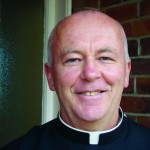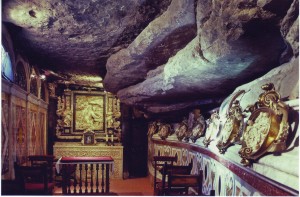Going to the Cave
In March,1522 Ignatius Loyola, a noble Basque soldier, recently recovered from war injuries, went on pilgrimage south to Montserrat, a monastery and Marian shrine near Barcelona. So he left the north of Spain, his own Basque country which he loved ardently as all Basques do, and went to Catalonia where they spoke Spanish, away from his old life. He was now a pilgrim, desiring God and His will, an unknown future before him. All he knew was that he wanted God to be first in his heart and in his life. What he did not know then, as he travelled south, was that God was giving him these good desires for a specific purpose and for what was to become very significant for the whole Catholic Church.
When Ignatius arrived at Montserrat, high on the jagged hills, he hung up his sword and spent the night in prayer to dedicate the next stage of his recently converted life to Our Lady. He then made characteristically a very detailed general confession to his monk confessor that we are told was spread over 3 days. To be converted we must first know what precisely God does not want in our lives, what significant disorders are there. Like a seasoned soldier Ignatius knew to first defend the castle we must particularly guard its weak points.
Then on 25 March,1522 he left Montserrat. He did not go far. He crossed the stone bridge over the Cardoner river, entering a nearby town called Manresa. Ignatius was to spend a year at that place in prayer and fasting, in consolation and in desolation, at times in confusion and despair, in fear and worry about past sins and other doubts. It was in a cave near Cardoner that he spent many hours of prayer that year.
But even more importantly, in that cave, guided by the Holy Spirit, Ignatius received a special grace or charism, of tremendous importance to the Church. He was led to understand there was a pattern in his conversion journey, as he reflected on what he himself had learnt from his own time of conversion and confusion and false steps and lights and graces received. Ignatius began to notice an overall order or design; how the good spirit moved him and how the evil spirit confused him. Ignatius acquired a taste for the things of God, and also a sense of what was not from God even though it seemed initially from God. He thought this order of conversion might be helpful to others who also want to surrender themselves to God.
There in the peace and quiet and isolation from the world, he wrote most of the book called The Spiritual Exercises, a series of meditations on the Christian conversion journey that have transformed and still are transforming the lives of millions of Christians. In our cult of the celebrity, Ignatius reminds Christians what immense good one person given over totally to God can do for the Kingdom. What he wrote is a work of spiritual genius.
Recently I was privileged to be in Manresa. It is a comfortable train journey not much more than an hour from Barcelona. In very stumbling guide book Spanish, with the help of a friendly traffic cop and the map he gave me, I found the Manresa pilgrim centre in a former Jesuit college. The attendant could not have been more pleasant and directed me well.
So I set out to the cave of St Ignatius near the Cardoner. I walked with light steps drawn to this holy place of transformation. I seemed to find it so easily. I was eager to enter it. There it was, next to the Jesuit Church. The cave is now a shrine to St Ignatius.
There is a entrance hallway and so I entered the cave. It did indeed feel a holy place. So I knelt in prayer so grateful to be finally there.
I noticed there was a light shining on the tabernacle and the door of the tabernacle had the image of the Nativity, with St Ignatius kneeling in front of the Christ child. St Joseph is pointing Ignatius to the child. Our Lady looks at Ignatius intently. In the background is a servant with water jars. As my gaze was drawn to this image, I was first surprised. Nativity and Ignatius? Isn’t it a bit too basic for such an exalted spiritual guide. Then as common sense took over, I felt that it was so right. Unless you become like a little child. Ignatius himself said once he put himself totally at God’s disposal: ‘during this time [at Manresa] God treated him as a teacher to a school child” Yes, what better place to learn what the Incarnation really means, finding God in the flesh, than in Bethlehem away from the stress and quest for success in the eyes of the world that had until recently been so important to Ignatius. In that cave of permanent transformation, Ignatius learnt to put God first in every aspect of the future 34 years of his life. God literally fuelled a fire in Ignatius’s heart that burnt brightly to help renew the 16th century Church.
The second feature that struck me was the image near the tabernacle of Ignatius writing the Exercises, pen and paper before him and yet looking over his shoulder to an image of Our Lady and the Christ as a baby. Our Lady had followed him from Montserrat. Ignatius realised once he had surrendered totally now he was called by the King Christ to serve under His standard modeling himself on only one pattern, the life, death and resurrection of Christ. And Our Lady was to be his gentle guide in that surpassing grace of knowing Christ Jesus Our Lord.
I spent a consoled time in prayer there, in that cave, praying for those who have helped me during my own experience of the Exercises and also in gratitude for the gift of leading others through them. St Ignatius, pray for us.



 Entries(RSS)
Entries(RSS)